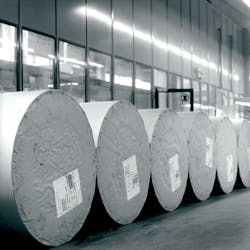“The North American, especially the U.S., pulp-and-paper industry has been in decline, capacity-wise, during the past decade or more,” observes Ken Patrick, pulp-and-paper technical lead for the Norcross, Ga.-based Technical Association of the Pulp and Paper Industry (TAPPI, www.tappi.org), and senior editor of the association’s “Paper 360°” magazine. He notes that decline occurred even as the per-capita demand—which in the United States is still the world’s highest—has leveled off.The last couple of years have been dramatically unkind. “In 2009, more than 20 North American mills went down permanently, on top of the 25 or so that shut their doors in 2008,” Patrick states. “The 2009 shutdowns represented an estimated loss of some 5.81 million metric tons per year (tpy) of capacity, following a loss of 6.73 million metric tpy in 2008.”Yet the U.S. market appears to be on the upswing, observes Jeff Curtis. “There is a significant amount of retail activity that is going on—and companies are making use of the latest technologies,” says the business development manager for forest products and printing in automation vendor Rockwell Automation Inc.’s (www.rockwellautomation.com) global solutions team, in Mecquon, Wis.Patrick adds that since the economic downturn, the domestic paper industry has returned to sounder footing, with capacity also stabilizing. “Since the first of this year, pricing has risen in most grade sectors, and most companies are currently operating in the black.” Market pulp prices rose to all-time highs by mid-2010 and have now begun moderating some, he adds. For the remainder of 2010, he predicts that the North American industry will “continue its currently high operating rates, under rather robust demand situations.” Those will arise because of “depleted customer inventories during the economic downturn.”Even with the economy-induced restructuring, the pulp-and-paper industry has also taken recent “giant” strides toward nanotechnology development and implementation, Patrick remarks. One indicator: “the first commercial U.S. production of nanocellulose announced earlier this summer.” The industry is expected to continue developments toward utilization of nanotechnology to manufacture superior paper, paperboard and related products, he adds—and, “in the near future, to expand production of nanocellulose.”The industry is also moveing ahead in the “intelligent” paper and packaging arena, Patrick says. One stride he mentions is the recent “significant” progress in developing grades and applications, such as tissue paper products, that react to viruses and germs by turning various colors to indicate infections. Another advance Patrick cites is programmable packaging. “It contains and tracks shipping data and product usage data.” There is also specialized medical and pharmaceutical packaging that “communicates” with users, as well as food packaging that interacts with storage and refrigeration, he states. He also comments that the industry has developed printing papers that react with—that is, instruct and/or program—printers, copiers and other devices.Increased use of liquid-cooled drives vs. air-cooled drives is also a stride forward, Rockwell’s Curtis notices. This is something relatively new to the paper industry, he explains. The attraction of more efficient liquid cooling is that it reduces cooling apparatus’ footprint by 50 percent, he says. Though he’s seen “good acceptance” of liquid cooling, Curtis doesn’t yet see “widespread” use in pulp-and-paper.But what is seeing more widespread use, according to Patrick, is installation of biomass-fueled process-waste steam boilers. Biomass, which encompasses so-called renewable energy resources such as wood and other combustible organic matter, is a “green” energy. “More than 10 such boilers have started up at North American mills during the past six months or so. At least as many are under development, with start-up planned for the near future,” he relates. Such internal reuse of energetic materials could help mills become less typical-fossil-fuel dependent—and that will help change financial ink color from red to black.C. Kenna Amos, [email protected], is an Automation World Contributing Editor.Technical Association of the Pulp and Paper Industry,TAPPIwww.tappi.orgRockwell Automation Inc.www.rockwellautomation.com
Subscribe to Automation World's RSS Feeds for Columns & Departments
About the Author
C. Kenna Amos
Contributing Editor
Sign up for our eNewsletters
Get the latest news and updates

Leaders relevant to this article:
